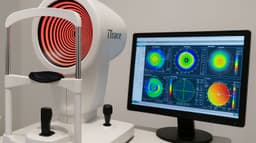
Can Laser Eye Surgery Fix Astigmatism?
Summary:
Astigmatism is a common vision problem that causes blurred or distorted vision due to an irregularly shaped cornea or lens. Many people wonder if laser eye surgery can correct this issue. The answer is a resounding YES! Laser eye surgery, particularly procedures like LASIK and PRK, has proven to be highly effective in treating astigmatism by reshaping the cornea to ensure light is properly focused onto the retina. This article will delve into how laser eye surgery works, its benefits, and what to expect from the procedure.
What Causes Astigmatism?
An irregularly shaped cornea or lens causes astigmatism. Instead of being perfectly round, like a basketball, the cornea or lens is shaped more like a football. This irregular shape causes light entering the eye to focus on multiple points instead of a single point on the retina, leading to blurred or distorted vision. Astigmatism can occur along with other refractive errors like nearsightedness or farsightedness.
Laser eye surgery, particularly procedures like LASIK (Laser-Assisted In Situ Keratomileusis) and PRK (Photorefractive Keratectomy), offers a highly effective solution to astigmatism. These surgeries use precise laser technology to reshape the cornea, correcting the irregular curvature and allowing light to focus properly on the retina. This correction significantly improves vision, reducing or even eliminating the need for glasses or contact lenses.

At What Age Can Astigmatism Be Fixed?
Prevalence of Astigmatism by Age Range and Recommended Treatments:
| Age Range | Prevalence of Astigmatism | Recommended Laser Eye Surgery |
|---|---|---|
| 0-20 years | High | PRK (preferred for developing eyes) |
| 21-40 years | Moderate | LASIK (common choice) |
| 41-60 years | Moderate | LASIK or PRK (depends on eye health) |
| 60+ years | High | PRK or other procedures (considering age-related eye changes) |
Definition and Types of Astigmatism
Astigmatism is a refractive error caused by an irregular shape of the cornea or lens, however, there are two there are two main types of astigmatism:
Corneal Astigmatism
Synopsis: Caused by an irregular shape of the cornea.
Corneal astigmatism occurs when the cornea, the clear, dome-shaped surface of the eye, has an irregular curvature. Instead of being perfectly round, like a basketball, the cornea in people with corneal astigmatism is shaped more like a football, with one meridian significantly more curved than the perpendicular meridian. This irregular shape causes light entering the eye to be refracted improperly, leading to multiple focal points on the retina rather than a single, clear point. As a result, vision can be blurry or distorted at all distances. Corneal astigmatism is the most common type of astigmatism and can be present at birth or develop over time due to factors like eye injury, surgery, or diseases such as keratoconus. It is often diagnosed through a comprehensive eye examination that includes keratometry and corneal topography to measure the curvature of the cornea. Treatments for corneal astigmatism include corrective lenses, such as glasses or contact lenses, and surgical options like LASIK or PRK, which reshape the cornea to improve vision.
Lenticular Astigmatism
Synopsis: Caused by an irregular shape of the lens.
Lenticular astigmatism is caused by an irregular shape of the lens inside the eye rather than the cornea. In a normal eye, the lens is evenly curved, allowing light to focus properly on the retina. However, in lenticular astigmatism, the lens has an uneven curvature, similar to how a misshapen lens in a camera would distort an image. This irregularity causes light to bend unevenly as it passes through the lens, resulting in blurred or distorted vision. Unlike corneal astigmatism, which affects the front surface of the eye, lenticular astigmatism occurs deeper within the eye and can sometimes be associated with conditions like cataracts. Diagnosis typically involves a thorough eye examination, including refraction tests to determine the lens's shape and impact on vision. Treatment options for lenticular astigmatism may include prescription glasses or contact lenses designed to compensate for the lens's irregular shape. In some cases, surgical interventions, such as cataract surgery with astigmatism-correcting intraocular lenses, can address the issue by replacing the misshapen lens with a properly shaped artificial one.

Symptoms and Diagnosis
Astigmatism can present with a range of symptoms that vary in severity. Here's a detailed look:
| Symptom | Severity | Recommended Action |
|---|---|---|
| Blurred or distorted vision at all distances | Mild to Severe | Schedule a comprehensive eye exam at My-iClinic |
| Eye strain or discomfort | Mild to Moderate | Consult with an optometrist at My-iClinic |
| Headaches | Moderate | Get a professional evaluation at My-iClinic |
| Difficulty seeing at night | Mild to Moderate | Book an appointment with My-iClinic |
| Squinting | Mild | Have your vision checked at My-iClinic |
Diagnosis of Astigmatism
Diagnosis of astigmatism typically occurs during a comprehensive eye exam conducted by an eye care professional. The examination includes several tests, such as a visual acuity test to measure how well you can see at various distances, keratometry to assess the curvature of the cornea, and a refraction test to determine the appropriate prescription for glasses or contact lenses. These tests help pinpoint the severity and type of astigmatism, ensuring accurate diagnosis and effective treatment planning. For a thorough and professional evaluation, consider visiting My-iClinic, a trusted provider for vision correction services.
My-iClinic Offers Free Online Tests
Free Laser Eye Test - Click Here
Free Suitability Test - Click Here
Free Astigmatism Test - Click Here
A full assessment is typically performed during a comprehensive eye exam. An eye doctor may use several tests, including:
Visual Acuity Test: Measures how well you can see at various distances.
Keratometry: Measures the curvature of the cornea.
Refraction Test: Determines the correct prescription for glasses or contact lenses.
Causes of Astigmatism
Astigmatism occurs when the cornea or lens of the eye is irregularly shaped, leading to blurred or distorted vision. This common refractive error can stem from various factors, including genetics, where individuals inherit a tendency towards irregularly shaped corneas or lenses. Trauma to the eye, such as injury or surgery, can also contribute to astigmatism. Additionally, conditions like keratoconus, where the cornea thins and bulges outward, can induce astigmatism. Changes in the shape of the lens due to ageing or conditions like diabetes may also play a role. Lastly, environmental factors such as excessive eye strain from prolonged near work or improper use of contact lenses might exacerbate astigmatism.
3 Primary Causes:
Genetics: Often hereditary, with a higher likelihood if parents have the condition.
Eye Injury or Surgery: This can cause scarring of the cornea, leading to astigmatism.
Keratoconus: A condition where the cornea becomes progressively thinner and more cone-shaped.
Laser Eye Surgery Solutions
Laser eye surgery offers several effective solutions for correcting astigmatism, with two primary options being LASIK (Laser-Assisted in Situ Keratomileusis) and PRK (Photorefractive Keratectomy). LASIK involves creating a thin flap in the cornea, reshaping the underlying tissue with a laser, and then repositioning the flap, while PRK reshapes the cornea's surface directly without creating a flap. Both procedures aim to alter the curvature of the cornea to correct the refractive error causing astigmatism. However, individuals with thinner corneas or certain corneal irregularities may be better suited for PRK, as it preserves more of the corneal tissue.

The suitability of LASIK or PRK for astigmatism correction can also depend on the patient's age. Generally, LASIK is often preferred for younger patients, typically those in their 20s to early 40s, as they are more likely to have stable vision. LASIK provides a quicker visual recovery and less discomfort compared to PRK. On the other hand, PRK may be recommended for older individuals, especially those over 40 or those with certain corneal characteristics, as it eliminates the risk of flap-related complications associated with LASIK. Additionally, PRK can be a suitable option for patients with thinner corneas or a history of dry eye syndrome. Consulting with an experienced eye surgeon is crucial to determine the most appropriate laser eye surgery option based on individual factors such as age, corneal thickness, and overall eye health.
Can Eye Laser Surgery Correct Astigmatism?
Eye laser surgery can correct astigmatism, and it is essentially the same as laser eye surgery. The terms "eye laser surgery" and "laser eye surgery" are often used interchangeably. Both refer to procedures where a laser is used to reshape the cornea to improve vision. For individuals with astigmatism, the laser can correct the irregular curvature of the cornea that causes blurred vision.
What's The Cost Of Laser Eye Surgery To Fix Astigmatism?
The average price for laser eye surgery to correct astigmatism in the UK typically ranges from £1,500 to £3,000 per eye. The cost varies depending on the type of procedure, such as LASIK, LASEK, or SMILE. Advanced procedures, like wavefront-guided LASIK, which provide more customised treatment, tend to be on the higher end of this range. My-iClinic offers a finance deal that includes consultations, follow-up care, toric lenses (Free of charge) and enhancements if needed. We also offer as standard:
- Be seen at your first appointment by the surgeon who will be doing your surgery
- Have your surgeon's mobile number
- Will be involved in decision-making
- Both eyes operated together.
Your Next Steps To Astigma Freedom!
Discover clearer vision and a brighter future with My-iClinic's specialised private solutions for astigmatism correction. Our team of experienced surgeons brings a wealth of expertise and a commitment to excellence in vision care. Whether you're considering LASIK or PRK, our tailored approach ensures personalised treatment plans designed to meet your unique needs. Take the first step towards a life without blurry vision—schedule your consultation with My-iClinic today!
Find out more by Speaking to our team









